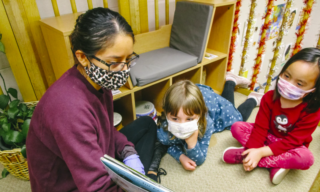Nearly 70% of Child Care Workers Report Struggling to Afford a Basic Need, Survey Finds
Elly Yu, LAist | August 20, 2025
Your donation will help us produce journalism like this. Please give today.
This story was originally published at LAist

The number of child care workers who struggle to meet basic needs like food, healthcare and housing is on the rise, according to a new report.
The Stanford Center on Early Childhood’s RAPID project started surveying child care providers around the country back in 2021, when about 40% of workers said they struggled to afford a basic need.
In March of this year, that rose to nearly 70% — the highest since the project started.
“ We’ve started to talk about some of these data as like representing the canary in a coal mine kind of a scenario,” said Philip Fisher, director of the Stanford Center on Early Childhood.
Since child care providers are among the lowest paid workers in the country, challenges in the economy — like the rising cost of food — “are hitting home for them more than they would for other people,” Fisher said. Providers have to buy goods like diapers and food for their child care centers that eat into their income. Many have had to make the decision to close their centers.
Where are the biggest problems?
One of the most notably worsening problem for child care providers has been health care — where nearly two-thirds of workers said it was a material hardship this past spring. In 2023, nearly 37% of child care workers were covered by Medi-Cal in California.
The majority childcare providers also said utilities were a struggle to afford.
Fisher said those two rise to the top because providers are often prioritizing their limited money on needs like housing and food.
“Food is something that people continue to try to acquire, even if they’re skipping meals. But utility payments typically go quickly and health care is another thing that typically goes out the window, because people are prioritizing other things when that happens,” he said.
He added that the rising numbers point to worsening economic challenges, like low wages and the rising costs of living.
“ I think we see that represented really clearly in this data that the people that we’re depending on to provide nurturing care and high quality care to our kids are themselves really earning at a level that makes it very difficult to subsist,” he said.
Want to learn more about child care issues in LA?
- How to find child care for your baby (and get help to pay for it)
- Head Start changes prompt confusion and worry for child care providers
- This LA preschool teacher closed her doors after almost 20 years. What does it say about the state of child care?
- California faces a growing deficit, but child care providers say they can’t wait for more pay